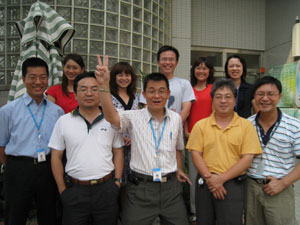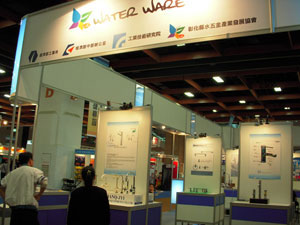ITRI's Water Ware Project Boosts Global Status of Taiwan's Faucet Industry
2009/05/07 | By Steve ChuangThe Changhua Water Ware Industry Development Association was inaugurated on Sept. 27, 2008, uniting over 150 upstream and downstream companies located in Changhua County, central Taiwan, in a joint effort to assure the sustainable development of their industry. The formation of the new association was triggered by the achievements of the Water Ware Project, a development effort led by the Mechanical and Systems Research Laboratories of the government-supported Industrial Technology Research Institute (ITRI).

Integrating government resources and industrial know-how, the project team has been busy since the project was launched in 2007 and has made important breakthroughs in molding and surface finishes technologies as well as IR (infrared) faucet applications. Some of these achievements were unveiled at the most recent Taiwan Hardware Show, which was held Oct. 23-25, 2008 in Taipei.
The following information has been excerpted from interviews with project manager Chen and team members Gun Yeou-bin and Chiang Chung-chien, both researchers in ITRI's Intelligent Robotics Technology Division.
Origins of the Project
In talking about the origins of the project, Chen noted that the Industrial Development Bureau (a unit of the Ministry of Economic Affairs, or MOEA) proposed a three-year project aimed at boosting the growth and development of a traditional Taiwanese industry having a significant regional industry cluster. ITRI was commissioned to head up the project.

Faucet manufacturing is one of the oldest industries on the island; originating in the town of Lugang, Changhua County, it has flourished for over half a century. However, Chen explained, what sets this industry apart is its industry cluster: "Up to 700 faucet and related makers have clustered within an area running over 30 kilometers. No place else can match Lugang in this density of faucet and related manufacturers."
Besides, Chen noted, compared with the conservation industry, which is oriented toward the domestic market, the faucet industry generates an average annual export value of NT$67 billion (about US$2.1 billion at NT$32:US$1) and is thus more worthy of government assistance, because the island relies heavily on export-driven economic growth. In its peak years the industry even controlled half of the U.S. market for brass faucets, which clearly indicates global competitiveness. Additionally, the manager went on, "The industry's seasoned production capability could help the project to progress more efficiently and effectively."
The project is running from 2007 through 2009, with NT$ 9 million being spent in each of the three years on the development of key technologies and innovative products. Although the investment is not very much, Chen said, the funds provide timely nourishment to the industry at a time when it is plagued with encroachments on its global market share by no-holds-barred price competition.
To put the limited related resources to the best use, Chen and his teammates opted to focus on automated gravity casting lines and trivalent chromium surface finishes, two key technologies for upstream and downstream production in the faucet industry, as well as water-recycling power generation systems for IR faucets.
Gravity Die Casting
In the automation of gravity die casting, which is Gun Yeou-bin's field, the team is attempting to apply robotic technology and to design suitable automated casting lines that can improve the defect rate and the work environment. At present, most Taiwanese die casting makers turn out faucet prototypes through sand casting and are generally backward when it comes to gravity die casting, which is popularly used to produce faucets in European countries mainly because it facilitates the development and production of high-end products.
"One reason why sand casting is more friendly to Taiwanese casting companies than gravity die casting is a longtime neglect of metal molds, caused largely by a lack of experience and resources," Gun says. "Manpower is another factor, because young people usually dislike working in traditional industries and poor work environments."
First, Gun pointed out, metal molds are key to gravity die casting; they can reduce pits in the surface of prototypes and enhance the quality of output, but they are also far more expensive than sand molds. Plus, production using metal molds costs more in terms of electricity consumption, and this discourages casting companies. Second, because of their lack of experience, Taiwanese casting companies are unfamiliar with the thermal dissipation characteristics and the time needed for the cooling of metal molds, which tends to result in defective products. Finally, they don't want to risk adopting metal molds unless they have confidence in strong technology support.
To encourage casting companies to work on gravity die casting, the Water Ware Project team decided to use robotic technology to achieve full automation. "Automation can improve production efficiency and help to control the characteristics of metal molds with computers, though it is costly," Gun said. "However, some manufacturers have shown a high interest in the joint establishment of an automated gravity die casting line, which can reduce their investment risk."
In addition to robotics technology, Gun's team is also helping companies with the development of suitable metal molds and production machinery. For example, it has used composite layers of metals in molds to improve thermal dissipation, and is planning to inspire machinery makers by organizing a group of them to visit Italian companies this year.
"We are scheduled to officially demonstrate an automated line based on robotic and computer technologies in 2009," Gun reported, "and this is expected to draw more attention to gravity casting. And, through the automation of gravity die casting lines, we want to help casting companies improve their average yield rate to 95%, from 70% now. Ultimately, we hope to see this technology widely adopted by the industry here."
Trivalent Chromium Surface Treatment
With the growing fondness for eco-friendly products worldwide, the prime task of Chiang Ching-chien is to help Taiwanese companies to replace hexavalent chromium with trivalent chromium in the surface finishes.
"Since its implementation of RoHS (Restrictions of Hazardous Substance), the European Union has strictly banned imports of products finished with solutions containing hexavalent chromium," Chiang commented. "This trend is growing steadily all over the world, and it forces Taiwanese faucet makers to seek out qualified surface treatment companies to replace hexavalent chromium with trivalent chromium. To secure the integrity of the industry cluster and to enhance its global presence, this is indispensable."
Chiang noted that only a few companies adopted trivalent chromium surface finishes applying other field in the past such as electronics and automation; however more and more customers form the U.S. and Europe are requesting environmentally-friendly processes deposited the surface of the lavatory products, which have forced Taiwanese faucet makers to pay more attention to the importance of trivalent chromium.
Treatment with solutions containing trivalent chromium is still more expensive than necessary with hexavalent chromium. This means that the related preprocesses are more complicated, especially the higher cost of chemical solutions, which is more than doubling the cost of the present treatment.
Chiang added that Changhua has about 20 professional surface finishes companies, but that their resources need to be integrated to help the faucet industry move more fully into trivalent chromium surface finishes. "This is what we are doing now," he said. "In fact, our team has upgraded trivalent chromium surface finishes to the latest version, which assures a better quality of brightness and anti-corrosion, and has better process stability. The important thing, though, is to convince manufacturers to use it, since it is still costly." In the near future, harmful environment process will be completely inhibited, but the technology is ready to be expanded very fast.
So the team is now helping companies to adopt the related technologies and solutions, and at the same time is trying to persuade more of them to accept the new methods so as to reduce costs, through economies of scale, to only 1.3 to 1.5 times those of using hexavalent chromium. Chiang's team is also helping surface finishes companies to apply for more official funding from such sources as the MOEA's Small Business Innovation Research Program.
Product Innovation
Believing that innovation is critical to the establishment of a positive association between quality and Taiwan-made faucets in the minds of buyers, the development team has put heavy emphasis on the creation of innovative products which, hopefully, will further bolster the industry's position and influence in the world.
In consideration of the growing trend toward eco-friendly, energy-stingy products in consumer markets, the team decided to concentrate on the improvement of water-recycling power generation systems for IR faucets. "For another thing," Gun stressed, "such an application can help differentiate Taiwan's faucet industry more distinctly from the Chinese industry."
Gun noted that the world's first water-recycling power generation system was created by ToTo, a leading global faucet and sanitary ware brand. "However," he continued, "ToTo's system still needs a battery as a complementary power source when the water flow is not strong enough to generate enough power for the next use of the faucet, mainly because its capacitor can't effectively store electricity. Addressing that drawback, we are confident that we can make a system better than ToTo's."
With tireless efforts to develop a truly green, battery-free water-recycling power generation system for IR faucets, the team has built into its system a "super capacitor" which, according to Gun, outperforms conventional models in electricity storage and allows the system to be completely free of lithium batteries. The team has further enhanced the performance of the system by designing and installing an extremely energy-stingy sensor and a low-inertia miniature power generator.
"We are proud of the system," Gun said, "because it is a truly eco-friendly product. But we will continue to fine-tune it by cutting down the size of the super capacitors, after which we plan an official launch in 2009. In the meantime, we have also created self-cleaning faucets and a recycling system for wastewater from RO (reverse osmosis) filtration. These are all innovative products developed in line with the concept of water conservation."
In 2009, the Water Ware Project's last year, Gun's team will switch its focus to the development of a slate of value-added products including rain showerheads, artistic faucets made of glass, and high-end faucets with an antimicrobial function.
"Most Taiwanese faucet makers, after years of hard work on technology upgrades and product R&D, have moved up from the bottom of the heap to ODM (original design manufacturing)," Chen concluded. "I am very optimistic that they will become innovatively and technologically stronger in the global market, as ITRI will continue to provide the help they need to continue their journey upmarket." (Jan. 2009)




